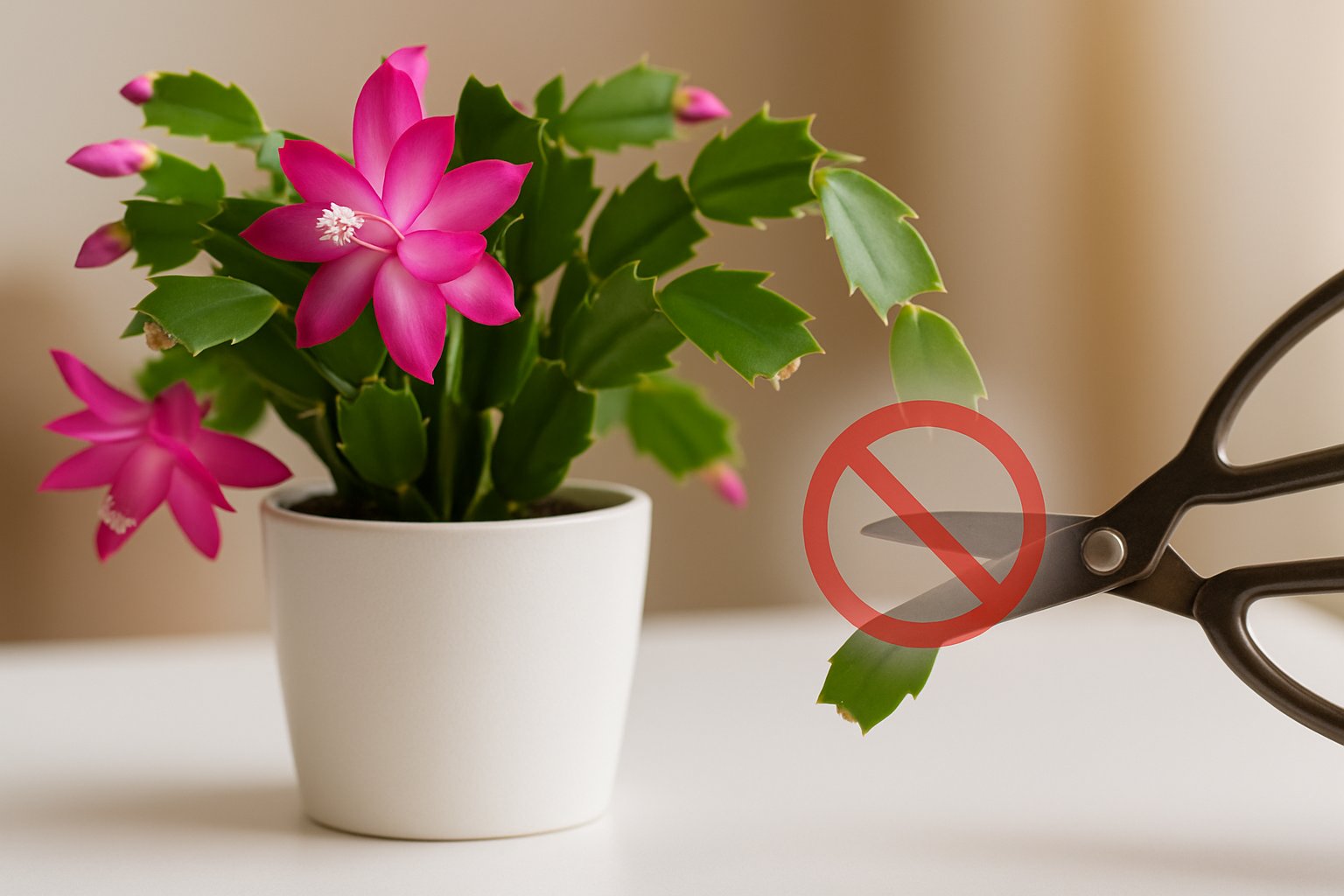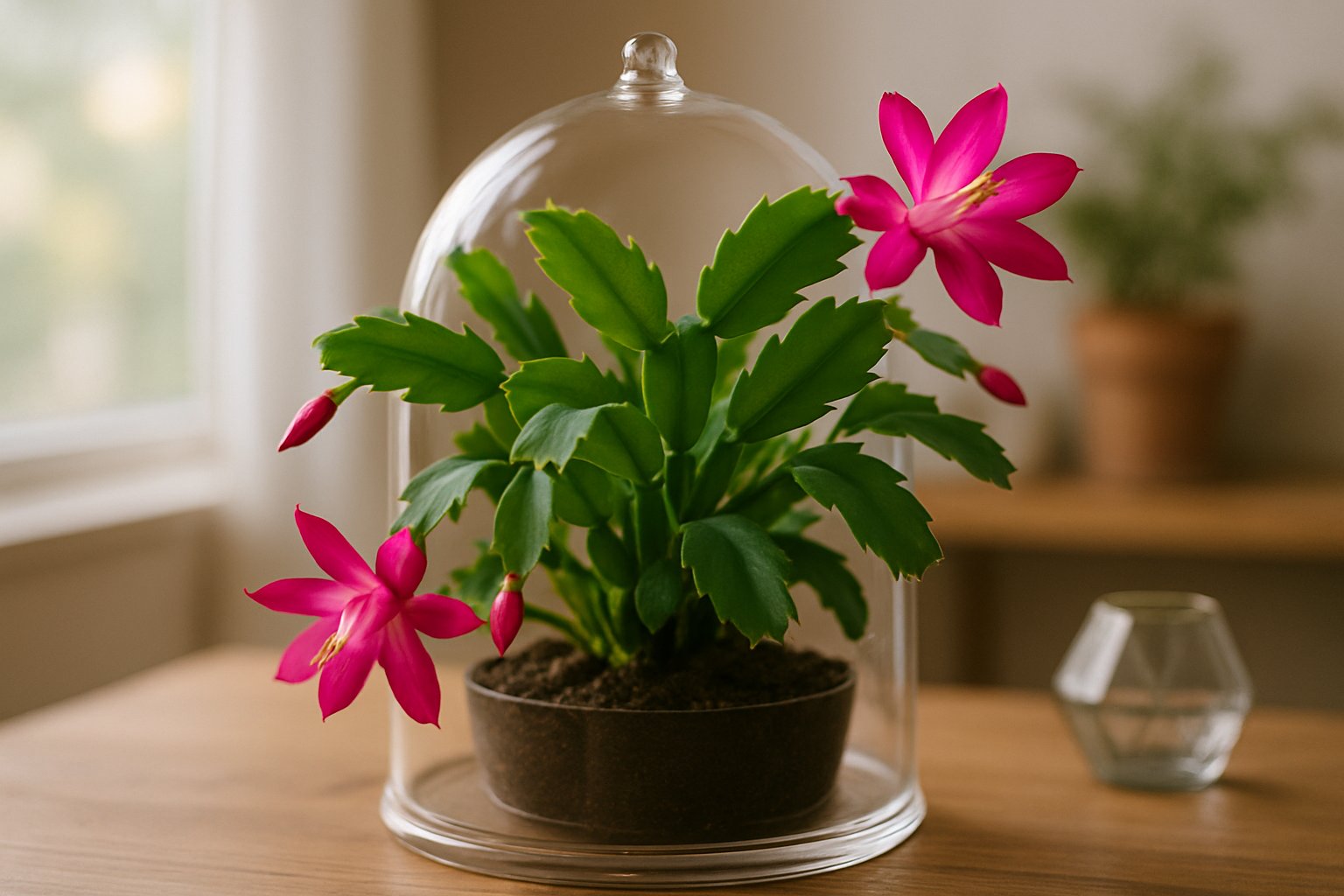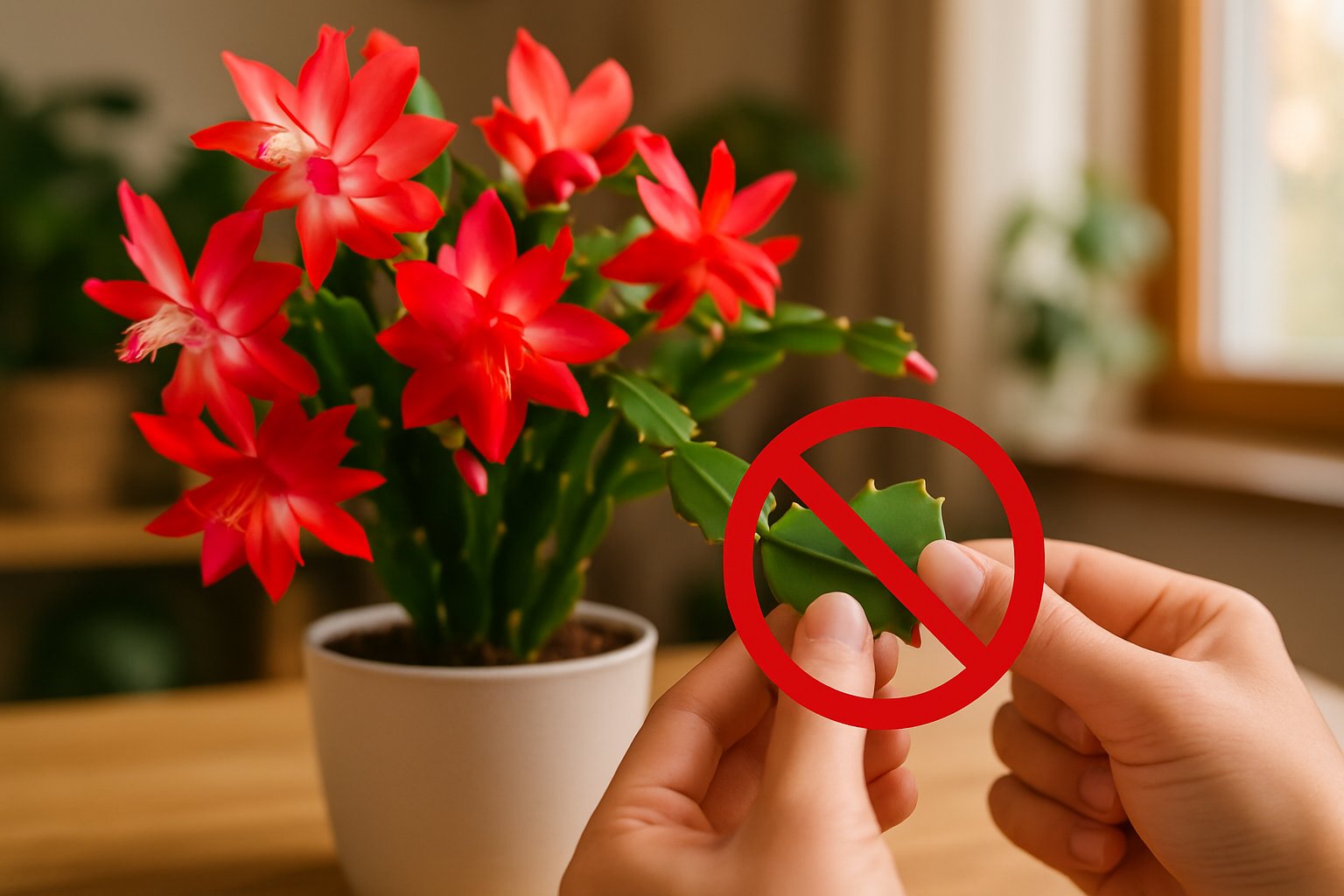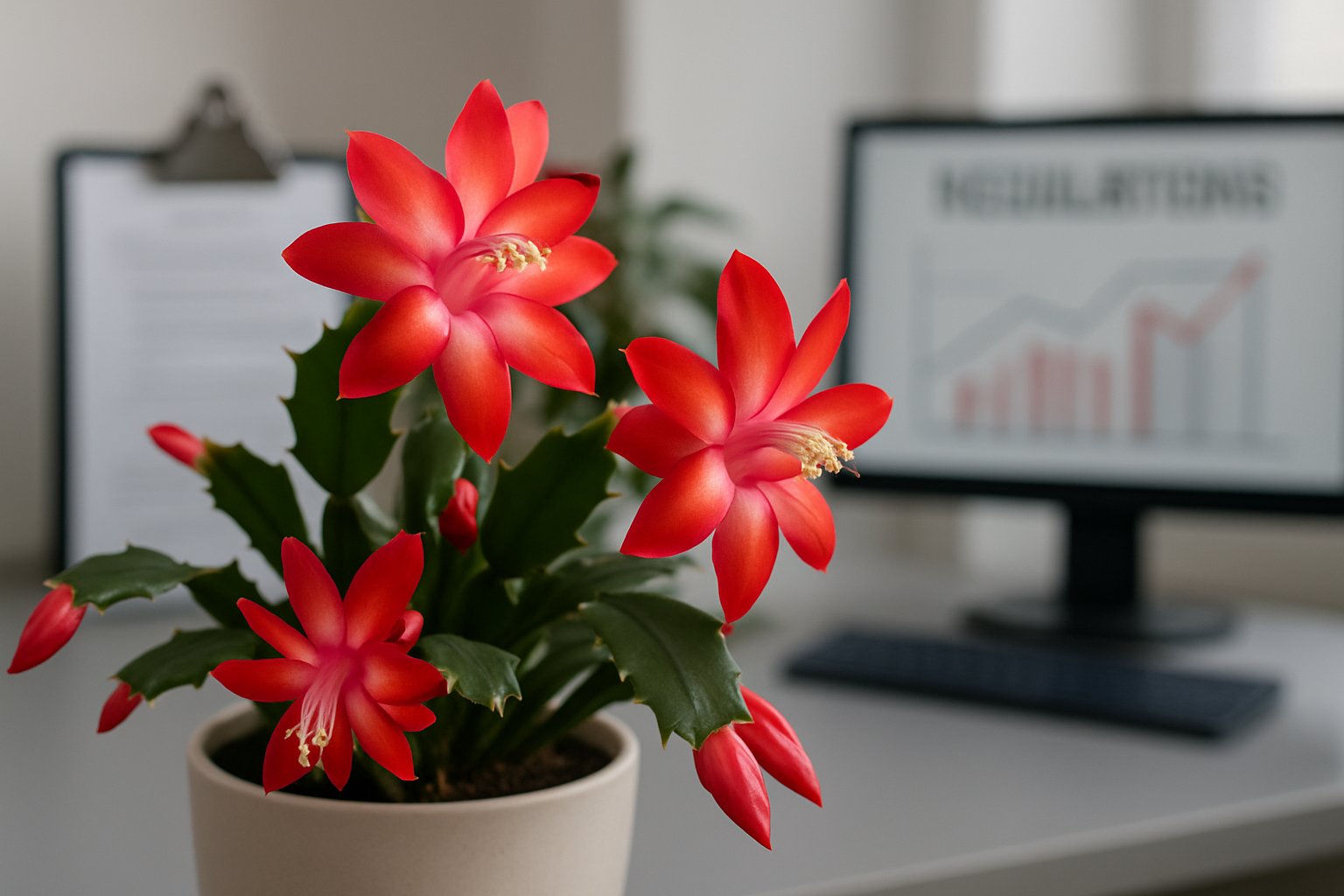So, you picked up a Christmas cactus and spotted a small tag that reads “propagation prohibited.” That label can throw you off—are you really not allowed to take cuttings from your own plant?
When a Christmas cactus comes with a “propagation prohibited” tag, it means the variety falls under a plant patent. This patent blocks you from reproducing and selling the plant for profit.

Here’s the thing—these restrictions mainly aim at commercial sellers, not hobbyists who just want to root a few cuttings for themselves or pass a piece to a friend. Patents have time limits, and enforcement can be spotty depending on your location.
If you know what these labels really mean, you’ll have an easier time deciding how to care for and share your Christmas cactus.
This guide covers what to watch for with propagation restrictions, how to tell if your plant is actually protected, and what you can do if you want more Christmas cacti—without breaking any rules.
Key Takeaways
- Propagation prohibited labels show plant patent protection, which mostly impacts commercial sellers, not home gardeners.
- You can own and enjoy patented plants, but reproducing them for profit can violate patent laws.
- There are legal ways to expand your Christmas cactus collection without crossing any legal lines.
Understanding Propagation Prohibited Labels

Plant patents shield new cultivars from unauthorized reproduction. Some regions also restrict certain species to keep ecosystems in check.
Home gardeners and commercial growers face different legal consequences if they ignore these restrictions.
Legal Implications for Home Gardeners
If you spot “propagation prohibited” on your Christmas cactus, it signals that a plant patent protects the variety. This means you can’t legally reproduce the plant for commercial gain.
For personal use, the rules get a bit looser. Usually, you can take cuttings for your own collection without trouble. But once you start selling or giving away propagated plants, you’re on thinner ice.
Here’s where you might run into problems:
- Commercial sales of rooted cuttings or new plants
- Distribution to others, even as gifts
- Trading with other plant enthusiasts
Enforcement usually targets commercial growers. Patent holders rarely go after individuals propagating for personal enjoyment.
No one is checking your living room for illegal cuttings. Nurseries and commercial operations are the real focus of these rules.
Common Reasons for Propagation Restrictions
There are two main reasons for Christmas cactus propagation bans: intellectual property protection and environmental safeguards.
Plant breeders put years into developing new varieties with special colors, longer bloom times, or compact habits. Patents protect those investments and keep others from cashing in on their work.
Some regions also flag certain Christmas cactus varieties as invasive. Those areas block propagation to keep native plants safe.
Patent-protected varieties tend to have:
- Unique flower colors
- Longer blooming seasons
- Compact or unusual growth patterns
- Improved resistance to disease
Environmental restrictions come into play when Christmas cacti might:
- Push out native species
- Disrupt local plant communities
- Escape gardens and spread unchecked
Role of Plant Patents and Intellectual Property
Plant patents work a lot like other intellectual property rights. Breeders get exclusive rights to grow and sell their new cultivars for a set period.
Most plant patents run for 20 years from the filing date. After that, anyone can propagate the variety freely.
Patent holders can license their varieties to authorized growers. These growers pay royalties to reproduce and sell those plants.
Patent info usually shows up on plant tags as:
- Patent numbers
- “Propagation prohibited” warnings
- Breeder or company names
You can look up patent status through the U.S. Patent and Trademark Office database. This lets you see which varieties are still protected and which are now open to propagate.
Licensed nurseries often charge more for patented varieties, since they pay royalty fees. That price difference reflects the value of the breeder’s work.
Why Is Christmas Cactus Propagation Prohibited?

There are two main reasons for banning Christmas cactus propagation: protecting endangered species from over-collection, and stopping invasive plants from causing trouble in native habitats. These rules help keep ecosystems balanced.
Conservation of Endangered Species
Some Christmas cactus species are endangered in the wild. Habitat loss and over-harvesting for the plant trade threaten these populations.
Propagation prohibited tags help protect these rare species. When nurseries can’t legally propagate certain types, there’s less pressure to collect them from the wild. That gives natural populations a fighting chance.
Not all Christmas cacti get this protection. For example, Schlumbergera truncata and Schlumbergera russelliana might have restrictions in certain regions.
These laws try to:
- Limit commercial propagation
- Lower demand for wild plants
- Allow natural populations to recover
- Promote growing common varieties instead
Prevention of Invasive Species Introduction
Christmas cactus can turn invasive in warm climates where they survive outdoors year-round. They spread fast and can crowd out native plants.
Propagation bans help control where these plants can take root. Some countries and states block propagation to avoid accidental introductions into their local flora.
Christmas cacti can cause problems because they:
- Adjust easily to new habitats
- Spread through broken stem pieces
- Compete for water, light, and nutrients
- They are tough to remove once established
Trouble spots include tropical and subtropical zones. Places like Hawaii, Florida, and parts of Australia enforce strict rules for non-native species.
Even houseplants can escape. Sometimes, people toss cuttings or unwanted plants outside, and the cactus finds a way to survive and multiply.
Regulations and Where They Apply

Rules about Christmas cactus propagation depend on the country. Some nations focus on plant patents, while others use trade laws to keep out non-native species.
International Plant Import and Export Laws
Most countries set strict guidelines for bringing plants across borders. These laws protect native ecosystems from invasive threats.
You can’t legally import Christmas cactus plants, seeds, or cuttings if they’re not native to your country. That even includes plants you rooted yourself.
The rules cover:
- Live plants
- Seeds
- Cuttings
- Rooted divisions
Customs inspectors enforce these laws. If you break them, you could face fines or see your plants confiscated.
Commonly restricted items:
- Plants with soil attached
- Fresh or untreated plant material
- Seeds without proper paperwork
Most plant imports require special permits. Getting one can take a while, so plan ahead if you’re thinking about it.
Country-Specific Christmas Cactus Propagation Bans
In the United States, plant patents control propagation. Patented Christmas cactus varieties can’t be reproduced without the patent holder’s okay.
Look for “Propagation Prohibited” tags on protected plants. That means you can’t make cuttings to sell or give away for profit.
Plant patents usually block:
- Taking and rooting cuttings
- Dividing mature plants
- Layering branches for new growth
- Any cloning techniques
These rules mainly target commercial growers. Home gardeners don’t get much attention for propagating a plant or two for themselves.
Other countries with similar setups:
- Canada
- European Union countries
- Australia
Growing from seed is generally fine, since patents only cover certain varieties, not the whole species.
How to Identify If Propagation Is Restricted

You can figure out if your Christmas cactus has propagation restrictions by checking plant tags and reading any documents that come with your plant. These restrictions mostly show up on patented varieties to protect breeders’ rights.
Reading Plant Tags and Labels
Look for phrases like “propagation prohibited” on the tag or sticker. Sometimes you’ll see “patent pending” or “asexual reproduction prohibited”—all of these mean you’re not allowed to take cuttings for commercial use.
Flip the tag over and check the back too. Important info often hides in small print.
Plant patents stick around for 20 years from the filing date. Once that’s up, you’re free to propagate the variety as much as you want.
Understanding Documentation and Permits
Plant patents protect specific cultivars that breeders developed. When you buy a patented Christmas cactus, you get to grow and enjoy it, but not to reproduce it for sale.
The main restriction is on making money from propagated plants. Selling, trading, or distributing cuttings without permission isn’t allowed.
Personal propagation for your own home is usually fine. Sharing cuttings with friends or family, though, sits in a bit of a legal gray area.
Hang onto your receipts and any paperwork from the nursery. Sometimes, those documents have patent info or contact details for the breeder—good to have if questions come up.
Legal Alternatives to Propagation

If you can’t legally propagate your Christmas cactus because of patent restrictions, don’t worry—there are still a couple of solid options. You could buy new plants from licensed sellers, or hunt down sources that don’t break any patent rules.
Purchasing Licensed Plants
Honestly, grabbing more Christmas cactus plants from a reputable garden center or nursery is the simplest route. These shops already pay for the right to sell patented varieties, so you don’t have to stress about paperwork or legal headaches.
Licensed nurseries usually stock healthy, mature plants—just as good as anything you’d propagate yourself. And you sidestep any legal concerns entirely.
Where to find licensed plants:
- Local garden centers
- Hardware stores with a greenhouse area
- Online plant shops
- Big box retailers like Home Depot or Lowe’s
Plenty of stores offer several Christmas cactus varieties on their shelves. With a little luck, you’ll spot different colors and bloom schedules too.
Buying from licensed sellers also supports the breeders behind these plants. Your purchase helps fund new cultivars and future improvements.
Growing from Permitted Sources
Some Christmas cactus cultivars don’t have patent protection anymore. Older varieties or those with expired patents are fair game for propagation.
Non-patented options include:
- Heirloom varieties from friends or family
- Plants that predate patent laws
- Types with expired patents (usually over 20 years old)
Once a patent expires, you can propagate your own Christmas cactus without any restrictions. It’s smart to check plant tags for patent numbers or expiration details.
Friends and family sometimes have those classic Christmas cactus plants. If they’re older, they might be non-patented varieties you can freely propagate.
Always double-check the patent status before you start a propagation project. If you’re unsure, stick with buying licensed plants to stay on the safe side.
Propagation Methods and Associated Risks
How you propagate a Christmas cactus can change the legal risks, especially with patented plants. Knowing these methods keeps you out of trouble while you expand your collection. Take a look at these tips for growing your plant collection without crossing any lines.
Cuttings and Their Legal Status
Most folks use cuttings to propagate Christmas cactus. You just snip a Y-shaped stem with three or more segments, then root it in water or soil.
Legal risks with cuttings:
- Taking cuttings for your own use is usually fine
- Selling or giving away cuttings from patented types breaks patent law
- Propagating commercially without approval can bring legal trouble
The “propagation prohibited” label targets this cutting method. Since you’re cloning the parent plant, patent holders want to control who can make more of their varieties.
Most home gardeners can take cuttings for themselves without worry. The issues pop up when you try to sell or share plants. Even giving a cutting to a friend can technically cross the legal line.
Propagation by Seeds or Grafting
When you grow Christmas cactus from seeds, you get plants that aren’t genetic clones of the parent. Seed-grown plants sidestep plant patent issues, which is handy. But let’s be honest—Christmas cactus seeds are tough to track down, and they’re slow to sprout.
Seed propagation benefits:
- You don’t have to worry about patent restrictions
- Gives you distinct plant varieties
- You can legally sell the plants you grow
With grafting, you take a segment from one plant and join it to another. This technique produces clones, just like taking cuttings does. Grafted plants still fall under the same patent rules.
Honestly, most folks stick with cuttings, even if there’s a legal gray area. Seeds just take forever to reach maturity. Grafting? It’s a bit advanced for the average home grower.
